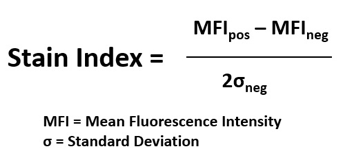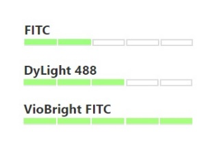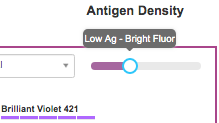When designing a flow cytometry experiment, it is important to consider the relative brightness of each fluorescent label on your specific instrument. Generally, it is best to assign brighter fluorochromes to weakly expressed markers, and dimmer labels to strongly expressed markers. However, a fluorochrome’s brightness can be affected by many factors, including signal intensity, background autofluorescence, non-specific staining, etc. Therefore, researchers need a way to normalize these factors and determine their fluorochromes’ relative brightness.
The Stain Index
The stain index measures the relative brightness of various fluorochromes on a given cytometer. This value can be used to compare and rank fluorochromes’ brightness.
To define a stain index, a panel of different fluorochromes conjugated to the same antibody clone are tested side by side on the same cytometer. The experiment can be performed using any strongly expressed marker with common antibodies available in multiple fluorochromes.
The stain index is calculated as the difference between the mean fluorescence  intensity of the positive and negative populations, divided by two times the standard deviation of the negative populations.
intensity of the positive and negative populations, divided by two times the standard deviation of the negative populations.
Once the stain index has been calculated, researchers can rank fluorophores by brightness and assign them appropriately to their flow cytometry panels.
Brightness Rating vs Stain Index
Fluorochrome suppliers typically provide a brightness rating of 1-5 for each label in their catalog. For example, FITC is rated brightness 2, DyLight™ 488 is brightness  3, and VioBright FITC is rated brightness 5. FluoroFinder displays these ratings during the panel design process to help researchers make quick decisions about fluorochromes’ relative brightness. Users can also prefilter available fluorochromes by using the antigen density slider during marker selection.
3, and VioBright FITC is rated brightness 5. FluoroFinder displays these ratings during the panel design process to help researchers make quick decisions about fluorochromes’ relative brightness. Users can also prefilter available fluorochromes by using the antigen density slider during marker selection.
However, as each supplier may use their own criteria to determine these relative brightness ratings, they should only be used as a general guide. Given the wide selection of available fluorochromes and variations in each cytometer, it is recommended that researchers calculate their own stain index. This is especially true for very sensitive experiments or when using a new fluorochrome for the first time.
Stain Index and Titration
Stain index values are also useful for evaluating titrations to find optimal antibody concentrations. Plotting the titration data using stain index vs concentration can be used to better visualize the titration calculation.
The stain index is critical for researchers to take into account when designing their experiments. Make sure that you are considering the staining index and avoiding these common mistakes researchers make when designing flow cytometry antibody panels. Consider consulting your Core Manager, or delegated core contact if you have questions about the stain index for your specific cytometer.






